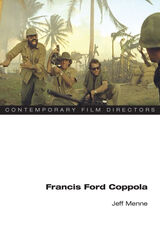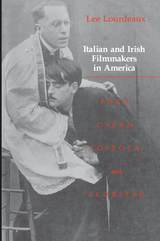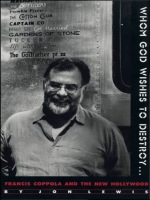4 books about Coppola, Francis Ford

Francis Ford Coppola
Jeff Menne
University of Illinois Press, 2014
Acclaimed as one of the most influential and innovative American directors, Francis Ford Coppola is also lionized as a maverick auteur at war with Hollywood's power structure and an ardent critic of the postindustrial corporate America it reflects.
However, Jeff Menne argues that Coppola exemplifies the new breed of creative corporate person and sees the director's oeuvre as vital for reimagining the corporation in the transformation of Hollywood.
Reading auteur theory as the new American business theory, Menne reveals how Coppola's vision of a new kind of company has transformed the worker into a liberated and well-utilized artist, but has also commodified individual creativity at a level unprecedented in corporate history. Coppola negotiated the contradictory roles of shrewd businessman and creative artist by recognizing the two roles are fused in a postindustrial economy.
Analyzing films like The Godfather (1970) and the overlooked Tucker: The Man and His Dream (1988) through Coppola's use of opera, Menne illustrates how Coppola developed a defining musical aesthetic while making films that reflected the idea of a corporation as family--and how his studio American Zoetrope came to represent a new brand of auteurism and the model for post-Fordist Hollywood.
However, Jeff Menne argues that Coppola exemplifies the new breed of creative corporate person and sees the director's oeuvre as vital for reimagining the corporation in the transformation of Hollywood.
Reading auteur theory as the new American business theory, Menne reveals how Coppola's vision of a new kind of company has transformed the worker into a liberated and well-utilized artist, but has also commodified individual creativity at a level unprecedented in corporate history. Coppola negotiated the contradictory roles of shrewd businessman and creative artist by recognizing the two roles are fused in a postindustrial economy.
Analyzing films like The Godfather (1970) and the overlooked Tucker: The Man and His Dream (1988) through Coppola's use of opera, Menne illustrates how Coppola developed a defining musical aesthetic while making films that reflected the idea of a corporation as family--and how his studio American Zoetrope came to represent a new brand of auteurism and the model for post-Fordist Hollywood.
[more]

Italian Irish Filmmakers
Lee Lourdeaux
Temple University Press, 1993
"This penetrating study examines how these filmmakers confronted their cultural heritage and used it as a counterpoint to their depiction of mainstream America."
--American Cinematographer
In this unique film history, Lee Lourdeaux traces the impact of Irish and Italian cultures on four major American directors and their work. Defining the core values and tensions within each culture, and especially focusing on the influence of American Catholicism, he presents John Ford, Frank Capra, Francis Coppola, and Martin Scorsese as ethnic Americans and film artists. Lourdeaux shows each filmmaker on set with writers and actors, learning to bypass stereotypes in order to develop a shrewd reciprocal assimilation between his ethnic background and Anglo America.
Beginning with D. W. Griffith's depiction of Irish and Italian immigrants, the author discusses Hollywood's stereotypical portrayals of ethnic priests, cops, politicians, and gangsters, as well as their surface acculturation in the movies of the 1920s. By the decade's end, John Ford was using all-American stories to embody the basic myths and tensions of Irish-American life. In his later westerns and foreign films, he tried to understand both Irish political strife and the key figures of Irish liturgy. Frank Capra pitted Italian family values against the Anglo success ethic, turning out social comedies about oppressed little people. Several decades later, Martin Scorsese and Francis Coppola were highly critical of their religio-ethnic heritage, though they gradually discovered that to outline its weaknesses, like the blind pursuit of success, was to fashion a critical mirror of mainstream America. Lourdeaux discusses a number of recent films by Coppola and by Scorsese that have not yet been analyzed in any book. And, in the chapter on Scorsese, a personal interview with the director reveals how his ethnic childhood shaped his work in film.
Examining the conflicts within American culture, Lourdeaux shows how the filmmakers themselves had to confront the self-destructive aspects of their ethnic background, not only to accommodate WASP audiences but to better understand their own heritage. He also observes that ethnicity is a strong draw at the box office, as in The Godfather, because it creates a sense of the Other who can both be admired and at the same time ridiculed. Illustrated with scenes of the movies discussed, this fascinating film history tells how four of America's most famous filmmakers assimilated their ethnic backgrounds on set and on screen.
"Mr. Lourdeaux walks a tricky path in analyzing the films of each [director]: avoiding the trap of excessively detailing their lives and many films, while steering clear of ethnic stereotyping. Those interested in ethnic influences on outstanding persons or in the production of films by four of the best will find the book enjoyable."
--The Baltimore Sun
"This is an invaluable book because it arouses critical awareness of the ethnicity underlying many Hollywood movies that might otherwise appear merely to represent American archetypes."
--Journal of American Studies
"A valuable addition to the literature on ethnic identity in film. The insights Lourdeaux offers into major figures like Griffith, Ford, Capra, Coppola, and Scorsese contribute significantly to our understanding of their films."
--Virginia Wright Wexman, University of Illinois at Chicago
"For a number of years now, church historians have been giving us an account of American Catholicism that is much richer and more varied than the older institutional accounts of the Catholic Church ever let on. In this comprehensive and insightful study, Lee Lourdeaux shows us how much the ethnic movies of directors like Ford and Capra, Coppola and Scorsese have to teach us as well about Irish- and Italian-Catholic mores and instincts."
--John B. Breslin, S.J., Director
"A wonderfully sensitive, intelligent study of the complex issue of how the Catholic imagination works in the creative personalities of those raised in the Catholic heritage."
--Andrew M. Greeley
[more]

Whom God Wishes to Destroy . . .
Francis Coppola and the New Hollywood
Jon Lewis
Duke University Press, 1995
In March 1980 Francis Coppola purchased the dilapidated Hollywood General Studios facility with the hope and dream of creating a radically new kind of studio, one that would revolutionize filmmaking, challenge the established studio machinery, and, most importantly, allow him to make movies as he wished. With this event at the center of Whom God Wishes to Destroy, Jon Lewis offers a behind-the-scenes view of Coppola’s struggle—that of the industry’s best-known auteur—against the changing realities of the New Hollywood of the 1980s. Presenting a Hollywood history steeped in the trade news, rumor, and gossip that propel the industry, Lewis unfolds a lesson about power, ownership, and the role of the auteur in the American cinema. From before the success of The Godfather to the eventual triumph of Apocalypse Now, through the critical upheaval of the 1980s with movies like Rumble Fish, Hammett, Peggy Sue Got Married, to the 1990s and the making of Bram Stoker’s Dracula and Kenneth Branagh’s Frankenstein, Francis Coppola’s career becomes the lens through which Lewis examines the nature of making movies and doing business in Hollywood today.
[more]

Youth Without Youth
Mircea Eliade
University of Chicago Press, 2007
Bucharest, 1938: while Hitler gains power in Germany, the Romanian police start arresting students they suspect of belonging to the Iron Guard. Meanwhile, a man who has spent his life studying languages, poetry, and history—a man who thought his life was over—lies in a hospital bed, inexplicably alive and miraculously healthy, trying to figure out how to conceal his identity.
At the intersection of the natural and supernatural, myth and history, dream and science, lies Mircea Eliade’s novella. Now in its first paperback edition, the psychological thriller features Dominic Matei, an elderly academic who experiences a cataclysmic event that allows him to live a new life with startling intellectual capacity. Sought by the Nazis for their medical experiments on the potentially life-prolonging power of electric shocks, Matei is helped to flee through Romania, Switzerland, Malta and India. Newly endowed with prodigious powers of memory and comprehension, he finds himself face to face with the glory and terror of the supernatural. In this surreal, philosophy-driven fantasy, Eliade tests the boundaries of literary genre as well as the reader’s imagination.
Suspenseful, witty, and poignant, Youth Without Youth illuminates Eliade’s longing for past loves and new texts, his erotic imagination, and his love of a thrilling mystery. It was adapted for the screen in 2007 as Francis Ford Coppola’s first feature film in over ten years.
“A wonderful blend of realism, surrealism, and fantasy, [Eliade’s novellas] suggest the importance of the mythic and the supernatural to finding meaning in the everyday. Highly recommended.” —Library Journal
“Youth Without Youth reads like a surreal collaboration by Jorge Luis Borges, Kurt Vonnegut, Jr., and Carl Jung. Mircea Eliade left me with the rare sense that I had been entertained by a genius.”—William Allen, author of Starkweather and The Fire in the Birdbath and Other Disturbances
At the intersection of the natural and supernatural, myth and history, dream and science, lies Mircea Eliade’s novella. Now in its first paperback edition, the psychological thriller features Dominic Matei, an elderly academic who experiences a cataclysmic event that allows him to live a new life with startling intellectual capacity. Sought by the Nazis for their medical experiments on the potentially life-prolonging power of electric shocks, Matei is helped to flee through Romania, Switzerland, Malta and India. Newly endowed with prodigious powers of memory and comprehension, he finds himself face to face with the glory and terror of the supernatural. In this surreal, philosophy-driven fantasy, Eliade tests the boundaries of literary genre as well as the reader’s imagination.
Suspenseful, witty, and poignant, Youth Without Youth illuminates Eliade’s longing for past loves and new texts, his erotic imagination, and his love of a thrilling mystery. It was adapted for the screen in 2007 as Francis Ford Coppola’s first feature film in over ten years.
“A wonderful blend of realism, surrealism, and fantasy, [Eliade’s novellas] suggest the importance of the mythic and the supernatural to finding meaning in the everyday. Highly recommended.” —Library Journal
“Youth Without Youth reads like a surreal collaboration by Jorge Luis Borges, Kurt Vonnegut, Jr., and Carl Jung. Mircea Eliade left me with the rare sense that I had been entertained by a genius.”—William Allen, author of Starkweather and The Fire in the Birdbath and Other Disturbances
[more]
READERS
Browse our collection.
PUBLISHERS
See BiblioVault's publisher services.
STUDENT SERVICES
Files for college accessibility offices.
UChicago Accessibility Resources
home | accessibility | search | about | contact us
BiblioVault ® 2001 - 2024
The University of Chicago Press









